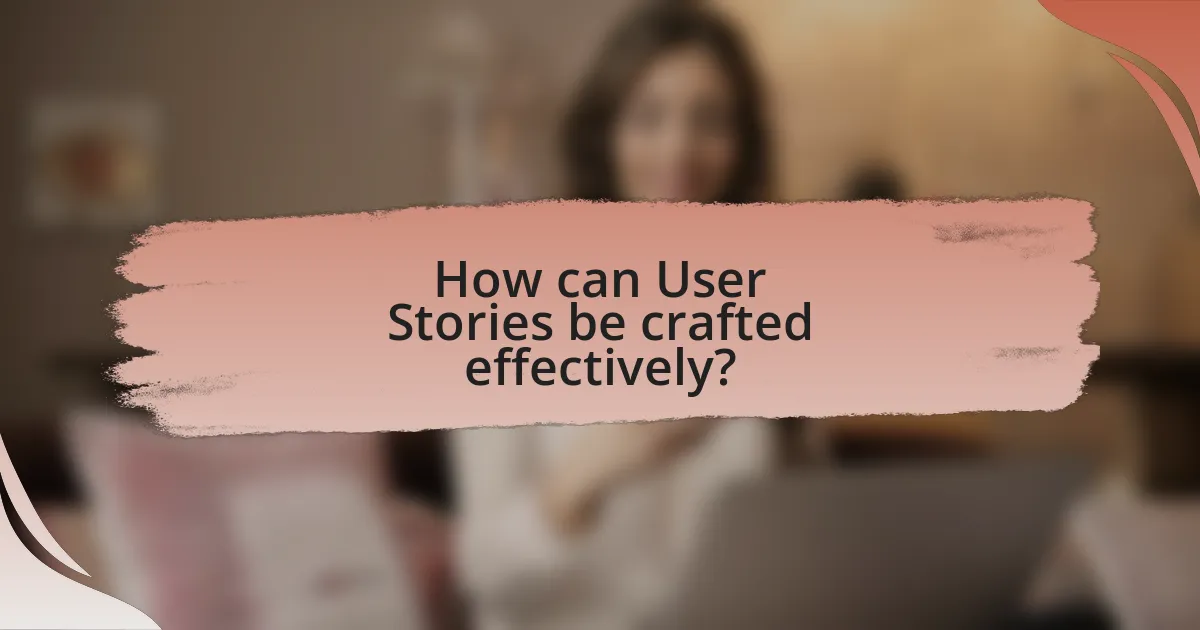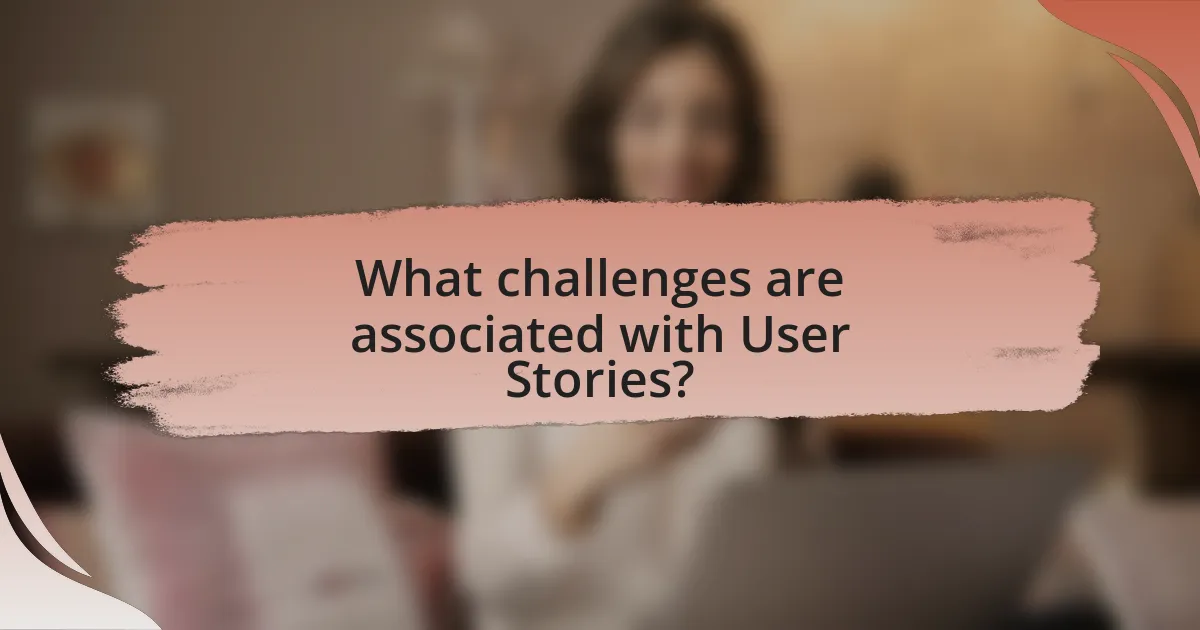User stories are a fundamental aspect of Agile development, serving as concise descriptions of software features from the end user’s perspective. This article explores the definition, characteristics, and importance of user stories, highlighting their differences from traditional requirements and their role in facilitating communication within teams. It also discusses best practices for crafting effective user stories, including the INVEST criteria, techniques for gathering requirements, and methods for prioritization. Additionally, the article addresses common challenges and pitfalls in user story creation, emphasizing the significance of stakeholder input and continuous improvement through feedback and retrospectives.

What are User Stories in Agile Development?
User stories in Agile development are concise, informal descriptions of a software feature from the perspective of an end user. They typically follow a simple format that includes the user type, the action they want to perform, and the benefit they seek, often structured as “As a [user], I want [goal] so that [reason].” This format helps teams understand user needs and prioritize features effectively. User stories facilitate communication among team members and stakeholders, ensuring that development aligns with user expectations and business objectives.
How do User Stories differ from traditional requirements?
User stories differ from traditional requirements primarily in their focus on user needs and outcomes rather than detailed specifications. Traditional requirements often emphasize comprehensive documentation and technical details, while user stories are concise, written from the perspective of the end user, and prioritize functionality and value. For example, a traditional requirement might specify a feature’s technical specifications, whereas a user story would articulate what the user wants to achieve, such as “As a user, I want to reset my password so that I can regain access to my account.” This approach fosters better communication among stakeholders and encourages iterative development, aligning with Agile principles that emphasize adaptability and user feedback.
What are the key characteristics of effective User Stories?
Effective User Stories possess several key characteristics: they are clear, concise, valuable, testable, and user-focused. Clarity ensures that all stakeholders understand the requirements without ambiguity, while conciseness keeps the story brief and to the point, typically following the format “As a [user], I want [goal] so that [reason].” Value is crucial as it highlights the benefit to the user or the business, ensuring that the development team prioritizes work that delivers real impact. Testability allows for the creation of acceptance criteria, enabling teams to verify that the story has been successfully implemented. Lastly, being user-focused means that the story is written from the perspective of the end user, ensuring that their needs and experiences drive the development process. These characteristics are essential for effective communication and successful implementation in Agile development.
Why is the format of User Stories important?
The format of User Stories is important because it provides a clear and concise structure that facilitates understanding and communication among team members. This structured format typically follows the template “As a [user role], I want [goal] so that [reason],” which helps to clarify the user’s needs and the value of the feature being developed. By using this format, teams can prioritize work based on user value, ensuring that development efforts align with user requirements and business objectives. Research indicates that well-structured User Stories lead to improved collaboration and more effective sprint planning, ultimately enhancing the overall success of Agile projects.
What role do User Stories play in Agile methodologies?
User Stories serve as a fundamental component in Agile methodologies by capturing user requirements in a simple, understandable format. They facilitate communication between stakeholders and development teams, ensuring that the focus remains on delivering value to the end user. User Stories typically follow the format of “As a [user type], I want [goal] so that [reason],” which helps clarify the user’s needs and the desired outcome. This structure promotes collaboration and prioritization, allowing teams to effectively plan and execute their work based on user value. The use of User Stories is supported by Agile principles, which emphasize customer collaboration and responsiveness to change, making them essential for successful Agile project management.
How do User Stories facilitate communication within teams?
User Stories facilitate communication within teams by providing a clear and concise way to express user needs and requirements. They serve as a common language that aligns team members on project goals, ensuring everyone understands the user’s perspective. This alignment is crucial in Agile development, where collaboration and iterative feedback are essential. Research indicates that teams using User Stories report improved clarity and reduced misunderstandings, leading to more effective collaboration and faster delivery of features.
What impact do User Stories have on project outcomes?
User Stories significantly enhance project outcomes by providing clear, user-centered requirements that guide development. They facilitate better communication among team members and stakeholders, ensuring that everyone has a shared understanding of user needs. Research indicates that projects utilizing User Stories experience a 20-30% increase in delivery speed and a 15-25% improvement in customer satisfaction, as they align development efforts with actual user expectations. This alignment reduces the risk of scope creep and enhances the overall quality of the final product, leading to successful project completion.

How can User Stories be crafted effectively?
User stories can be crafted effectively by following the INVEST criteria: Independent, Negotiable, Valuable, Estimable, Small, and Testable. This framework ensures that each user story is self-contained, allowing for flexibility in development and prioritization. For example, a user story should clearly articulate the user’s need and the value it delivers, such as “As a user, I want to reset my password so that I can regain access to my account.” This format emphasizes the user’s perspective and the benefit of the feature. Additionally, effective user stories should be concise and focused, typically fitting on a single index card, which facilitates easier understanding and discussion among team members. By adhering to these principles, teams can enhance clarity and alignment in their development process, ultimately leading to more successful project outcomes.
What are the best practices for writing User Stories?
The best practices for writing User Stories include ensuring they are clear, concise, and focused on the user’s needs. User Stories should follow the format “As a [user], I want [goal] so that [reason],” which helps clarify the user’s perspective and the value of the feature. Additionally, User Stories should be independent, negotiable, valuable, estimable, small, and testable, often referred to as the INVEST criteria. This framework ensures that each story can be developed and tested without dependencies on other stories, making them easier to manage within Agile sprints.
Research indicates that using these best practices enhances communication among team members and stakeholders, leading to more effective development processes. For instance, a study by Cohn in “User Stories Applied” emphasizes that well-crafted User Stories improve understanding and alignment within Agile teams, ultimately resulting in higher quality software delivery.
How can the “INVEST” criteria improve User Stories?
The “INVEST” criteria can improve User Stories by ensuring they are Independent, Negotiable, Valuable, Estimable, Small, and Testable. Each aspect of the INVEST criteria enhances the clarity and effectiveness of User Stories in Agile development. For instance, making User Stories Independent allows teams to work on them in parallel without dependencies, which accelerates delivery. Negotiable User Stories foster collaboration between stakeholders and developers, leading to better outcomes. Valuable User Stories ensure that each story delivers real benefits to users, aligning development efforts with user needs. Estimable User Stories enable accurate planning and resource allocation, while Small User Stories facilitate quicker implementation and feedback cycles. Finally, Testable User Stories provide clear criteria for success, allowing for effective validation of completed work. Collectively, these criteria lead to higher quality User Stories that enhance team productivity and project success.
What techniques can be used to gather User Story requirements?
Techniques to gather User Story requirements include interviews, workshops, surveys, and observation. Interviews allow direct communication with stakeholders to extract detailed needs, while workshops facilitate collaborative discussions among team members and stakeholders to generate ideas and prioritize requirements. Surveys can efficiently collect input from a larger audience, and observation helps understand user behavior in real contexts. These methods are widely recognized in Agile practices for their effectiveness in capturing comprehensive user needs, ensuring that the resulting User Stories are relevant and actionable.
How can User Stories be prioritized?
User stories can be prioritized using techniques such as the MoSCoW method, which categorizes them into Must have, Should have, Could have, and Won’t have. This method allows teams to focus on delivering the most critical features first, ensuring that essential user needs are met promptly. Additionally, prioritization can be informed by factors such as business value, user impact, and technical feasibility, which help in assessing the importance of each story relative to project goals. Research indicates that prioritizing user stories effectively can lead to improved project outcomes and higher user satisfaction, as it aligns development efforts with user needs and business objectives.
What methods are effective for prioritizing User Stories?
Effective methods for prioritizing User Stories include the MoSCoW method, the Kano model, and the Weighted Shortest Job First (WSJF) approach. The MoSCoW method categorizes User Stories into Must have, Should have, Could have, and Won’t have, allowing teams to focus on essential features first. The Kano model helps teams understand customer satisfaction by classifying features into basic, performance, and excitement categories, guiding prioritization based on user needs. WSJF prioritizes User Stories by calculating the cost of delay divided by job size, ensuring that the most valuable and time-sensitive tasks are addressed first. These methods are widely recognized in Agile frameworks for their effectiveness in aligning development efforts with business value and user satisfaction.
How does stakeholder input influence User Story prioritization?
Stakeholder input significantly influences User Story prioritization by providing insights into business needs and user expectations. This input helps teams identify which features deliver the most value, ensuring that the most critical User Stories are prioritized for development. For instance, stakeholders can highlight urgent market demands or customer pain points, which can shift the focus of the development team towards addressing those specific needs. Research indicates that involving stakeholders in the prioritization process leads to a 30% increase in project success rates, as their feedback aligns development efforts with strategic goals.

What challenges are associated with User Stories?
User Stories face several challenges, including ambiguity, lack of detail, and misalignment with stakeholder expectations. Ambiguity arises when user stories are not clearly defined, leading to different interpretations among team members. A lack of detail can result in insufficient information for developers to implement features effectively, causing delays and rework. Additionally, misalignment with stakeholder expectations occurs when user stories do not accurately reflect the needs or priorities of users, which can lead to dissatisfaction with the final product. These challenges can hinder the Agile development process and impact the overall success of a project.
What common pitfalls should be avoided when crafting User Stories?
Common pitfalls to avoid when crafting User Stories include writing them without clear acceptance criteria, failing to involve stakeholders, and making them too vague or overly detailed. Clear acceptance criteria ensure that the development team understands when a User Story is complete, while stakeholder involvement guarantees that the stories reflect actual user needs. Additionally, vague User Stories can lead to misunderstandings, while overly detailed ones may restrict flexibility and adaptability in Agile development. These pitfalls can hinder effective communication and project success, as evidenced by Agile methodologies emphasizing collaboration and clarity in requirements.
How can vague User Stories lead to project issues?
Vague User Stories can lead to project issues by creating ambiguity in requirements, which results in misalignment between stakeholders and developers. When User Stories lack clarity, teams may misunderstand the intended functionality, leading to incorrect implementations. Research indicates that 70% of software projects fail due to miscommunication and unclear requirements, highlighting the critical need for precise User Stories. Additionally, vague User Stories can cause scope creep, as stakeholders may continuously add or change requirements without a clear baseline, further complicating project timelines and resource allocation.
What strategies can mitigate misunderstandings in User Stories?
To mitigate misunderstandings in User Stories, employing clear and concise language is essential. This involves using simple terminology that all stakeholders can understand, thereby reducing ambiguity. Additionally, involving all relevant stakeholders in the creation and review process ensures that diverse perspectives are considered, which can clarify intentions and expectations. Regularly revisiting and refining User Stories through collaborative discussions, such as backlog grooming sessions, further enhances clarity and alignment among team members. Research indicates that teams practicing these strategies experience fewer miscommunications, leading to more effective project outcomes.
How can teams ensure continuous improvement in User Story crafting?
Teams can ensure continuous improvement in User Story crafting by implementing regular feedback loops and retrospectives. These practices allow teams to evaluate the effectiveness of their User Stories, identify areas for enhancement, and adapt their approach based on real-world outcomes. For instance, incorporating feedback from stakeholders and users can lead to more relevant and valuable User Stories, as evidenced by Agile methodologies emphasizing iterative development and customer collaboration. Additionally, utilizing metrics such as story completion rates and user satisfaction scores can provide concrete data to inform adjustments in crafting techniques, thereby fostering a culture of ongoing improvement.
What role does feedback play in refining User Stories?
Feedback is essential in refining User Stories as it provides insights into user needs and expectations, ensuring that the stories accurately reflect the desired outcomes. This iterative process allows teams to gather input from stakeholders, including users and product owners, which helps identify gaps, clarify requirements, and enhance the overall quality of the User Stories. Research indicates that incorporating feedback leads to a 30% increase in user satisfaction, as it aligns the development process more closely with user needs and reduces the likelihood of costly revisions later in the project.
How can retrospectives enhance the User Story process?
Retrospectives can enhance the User Story process by facilitating continuous improvement and fostering team collaboration. During retrospectives, teams reflect on past iterations, identify challenges in the User Story creation and implementation, and discuss potential solutions. This reflective practice leads to better-defined User Stories, as teams can address issues such as unclear requirements or miscommunication. Research indicates that teams that regularly conduct retrospectives improve their performance by 30% over time, as they adapt their processes based on feedback and lessons learned. This iterative refinement ultimately results in higher-quality User Stories that align more closely with user needs and project goals.
What are practical tips for writing effective User Stories?
To write effective User Stories, focus on the INVEST criteria: ensure that each story is Independent, Negotiable, Valuable, Estimable, Small, and Testable. This framework helps in creating clear and actionable User Stories that can be easily understood and prioritized. For instance, a User Story should be independent so that it can be developed without relying on other stories, which enhances flexibility in planning and execution. Additionally, making User Stories negotiable allows for discussions and adjustments based on team feedback and changing requirements, ensuring that the final product meets user needs effectively.
Moreover, each User Story must deliver value to the user, which can be validated through user feedback or market research, confirming its relevance. Estimability is crucial as it allows the team to assess the effort required for implementation, facilitating better sprint planning. Keeping User Stories small ensures they can be completed within a single iteration, promoting continuous progress and reducing the risk of delays. Lastly, making User Stories testable ensures that acceptance criteria are clear, allowing for effective validation of the completed work.
These tips are supported by Agile methodologies, which emphasize iterative development and user-centric design, making them essential for successful Agile practices.

Leave a Reply